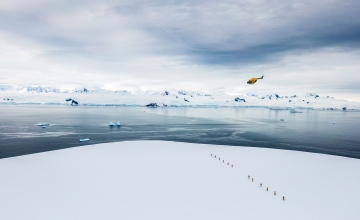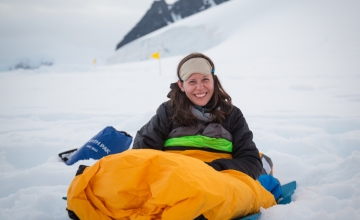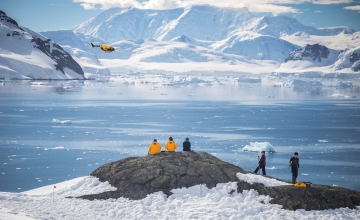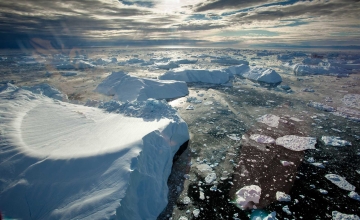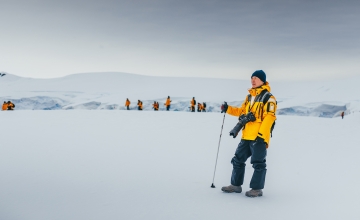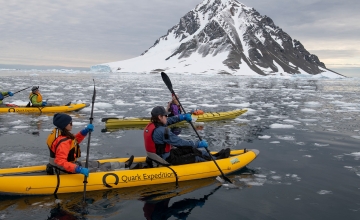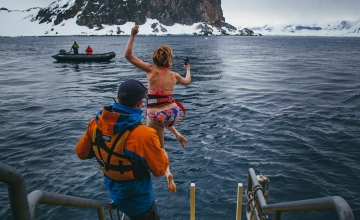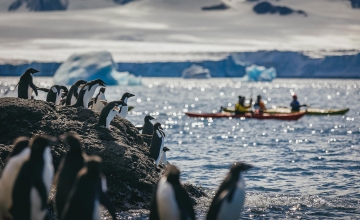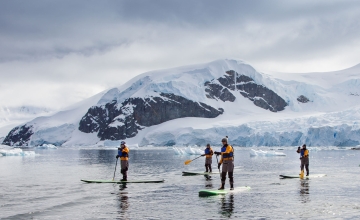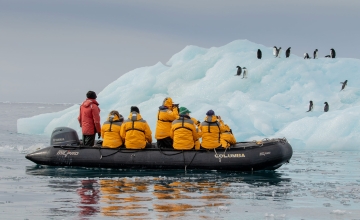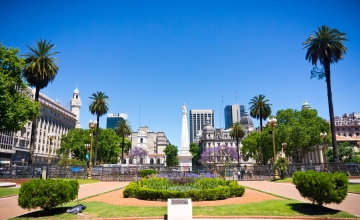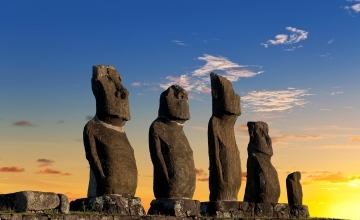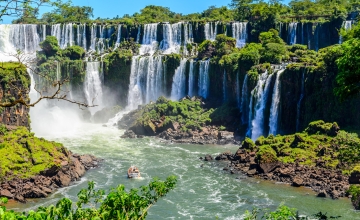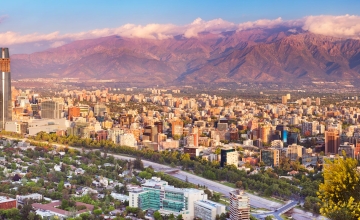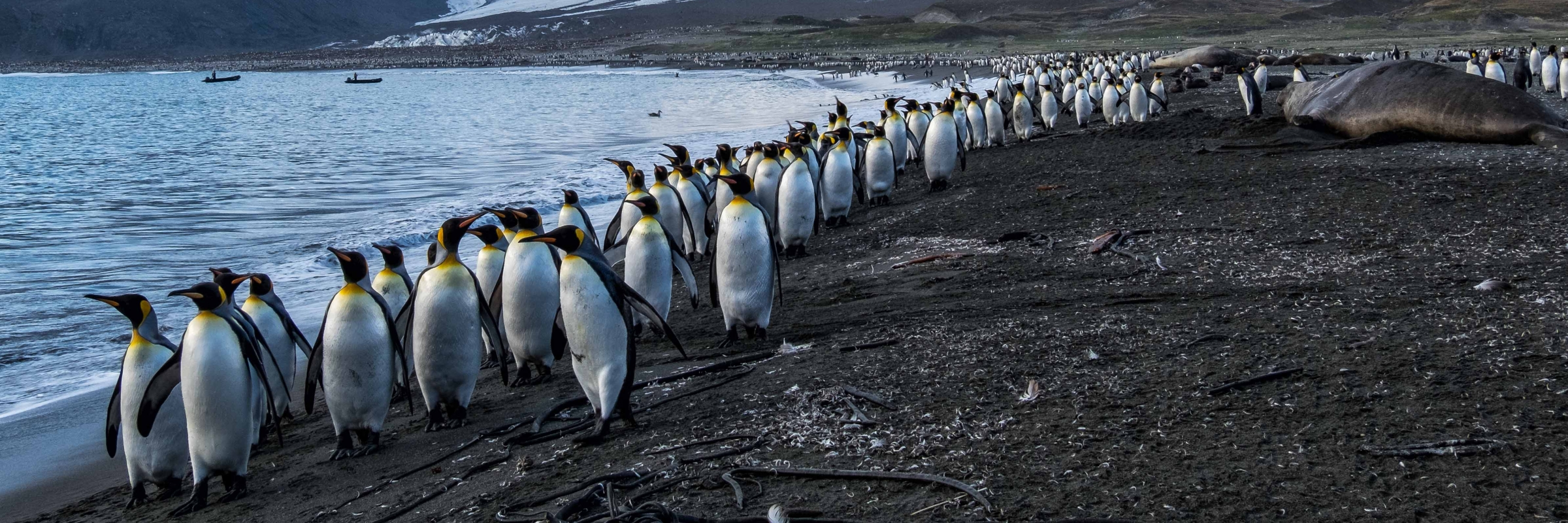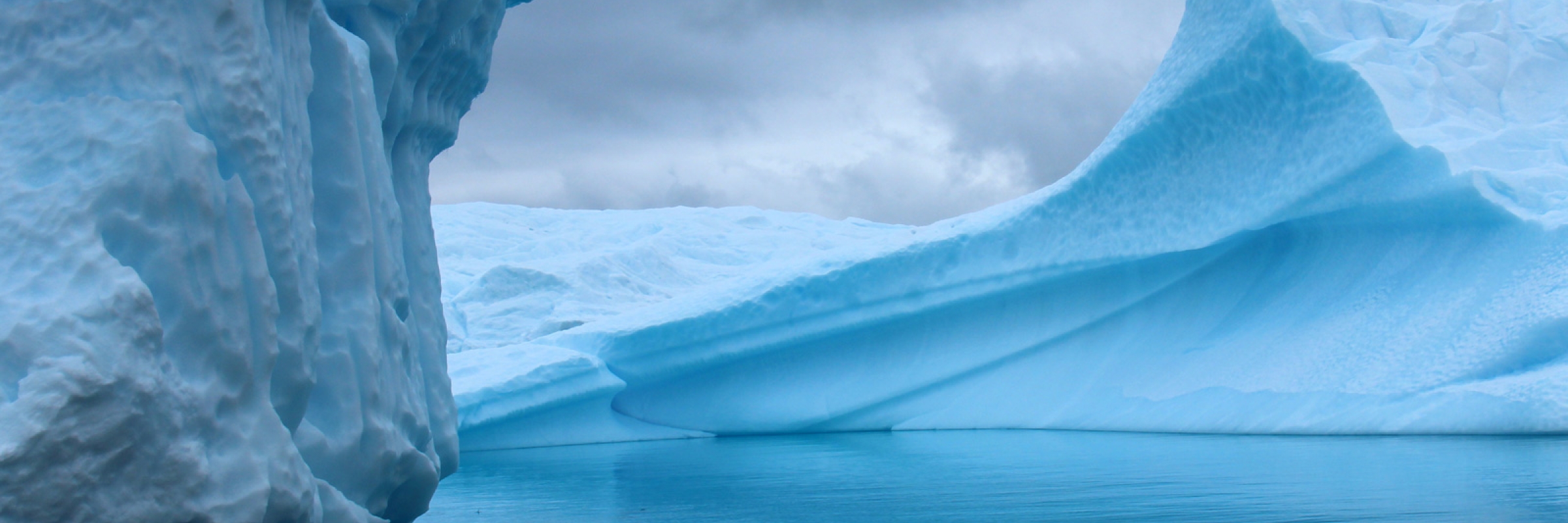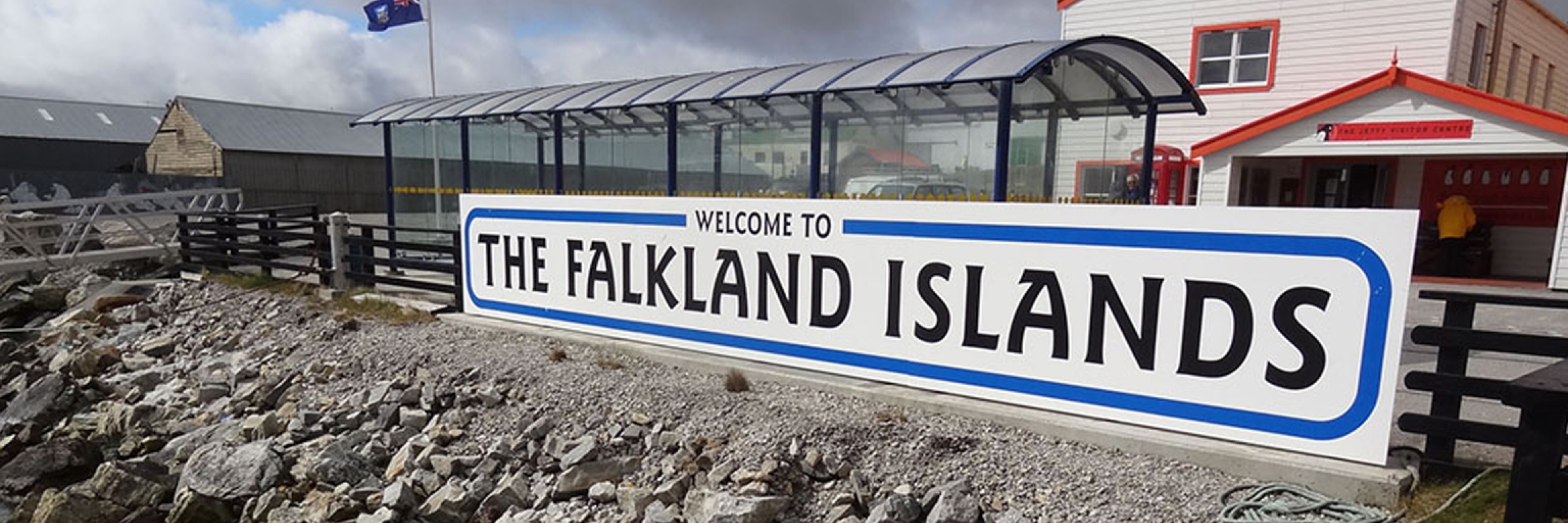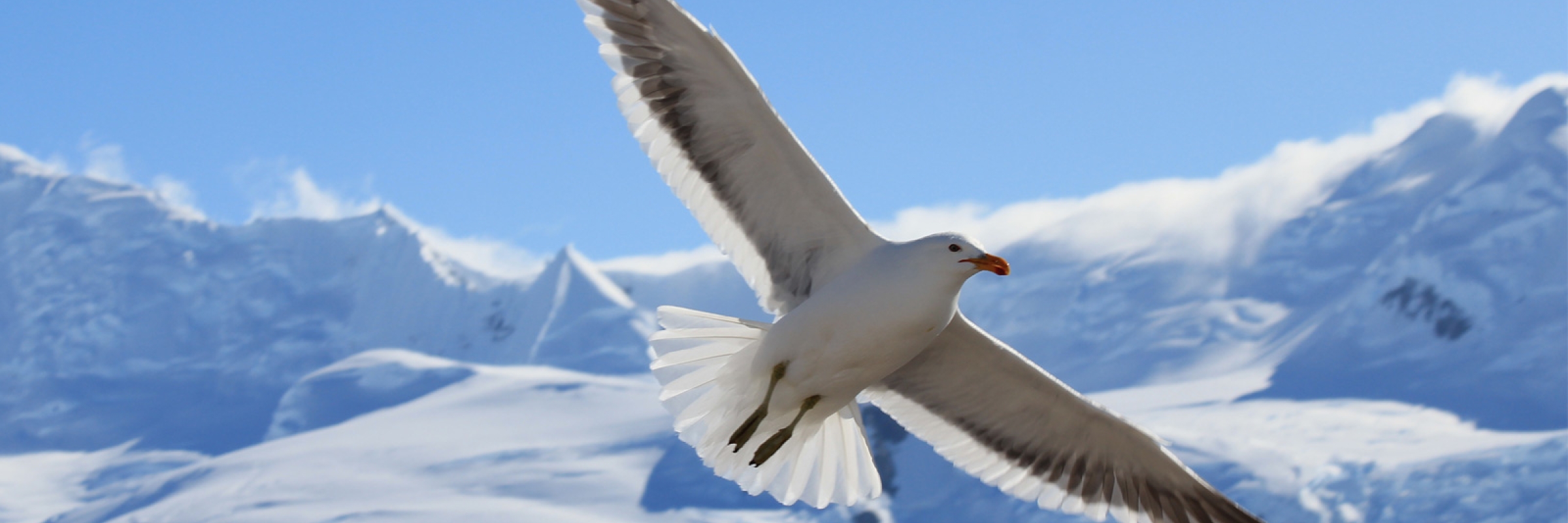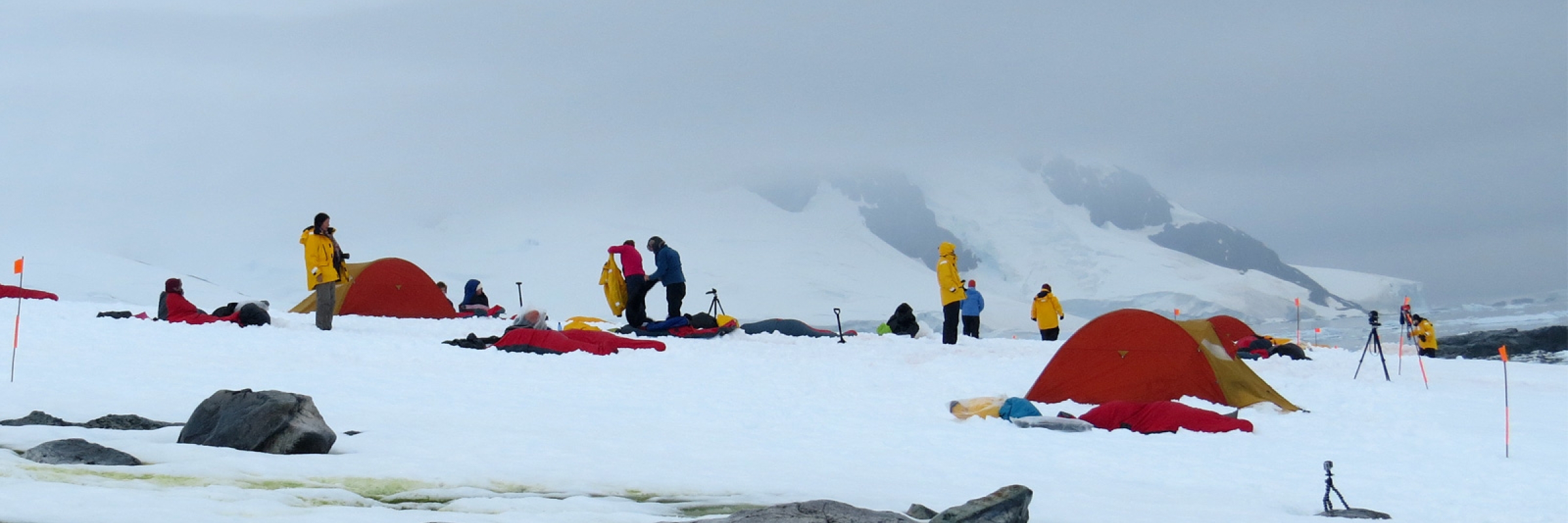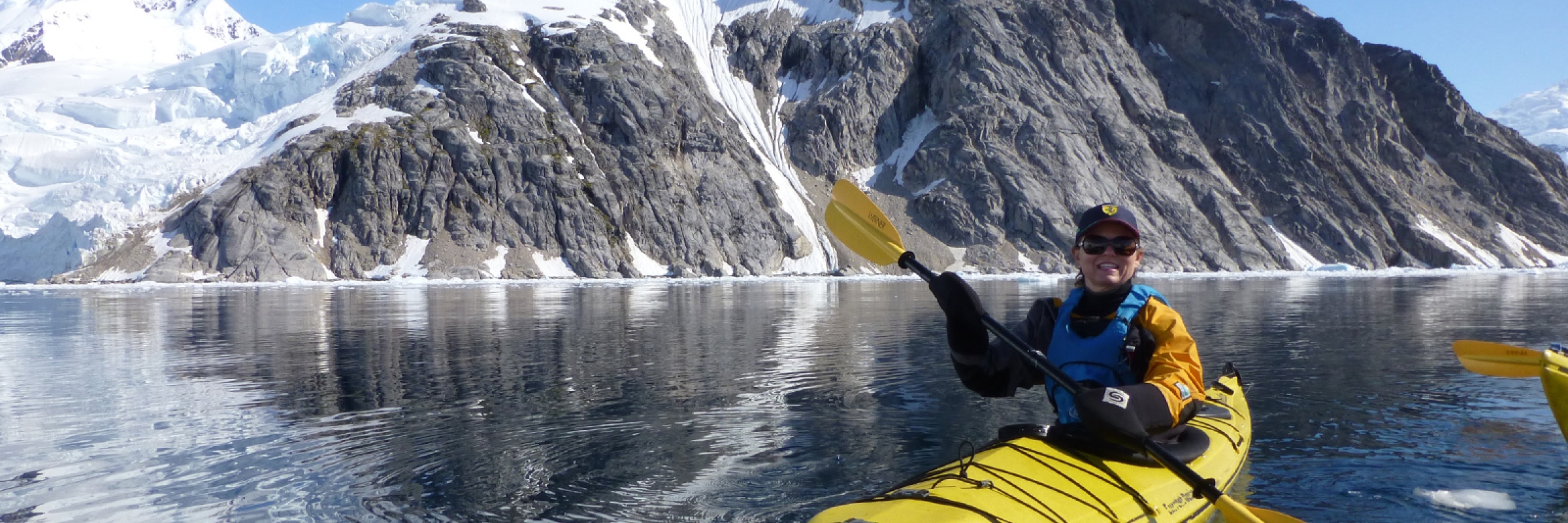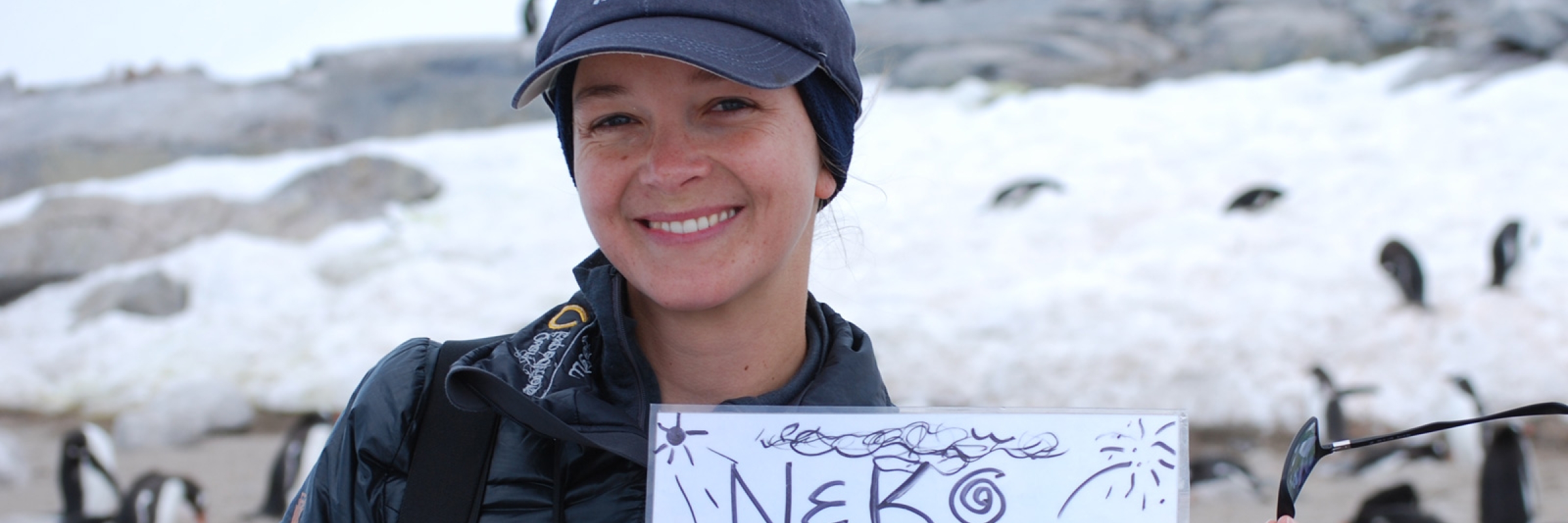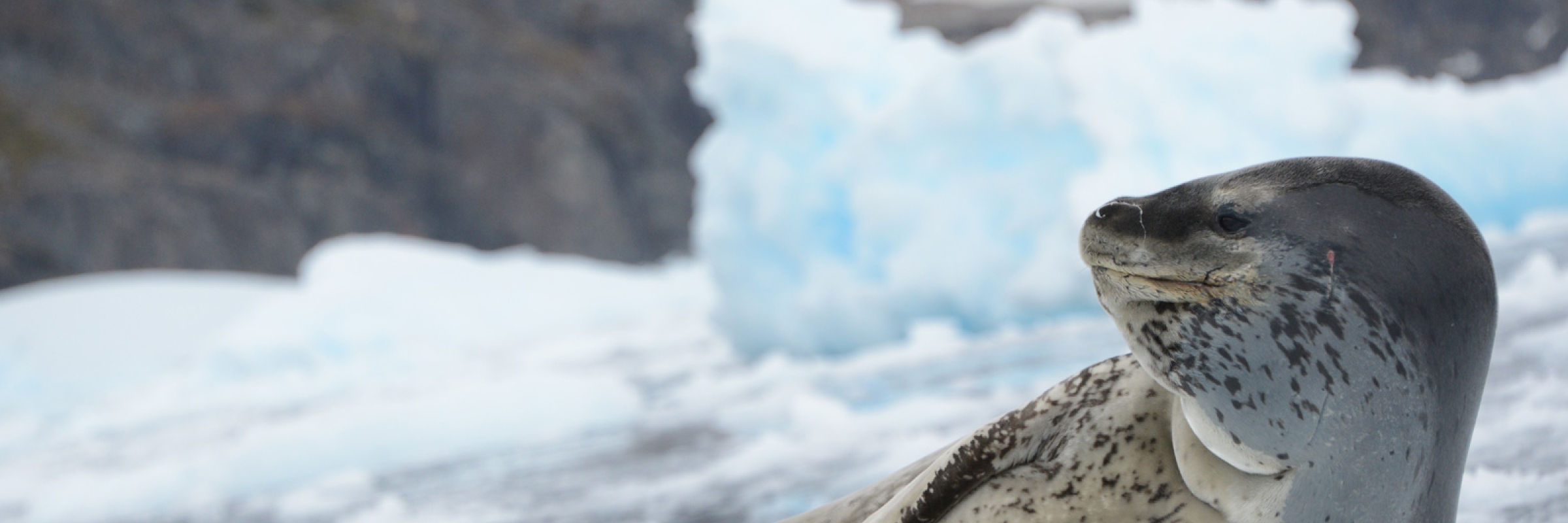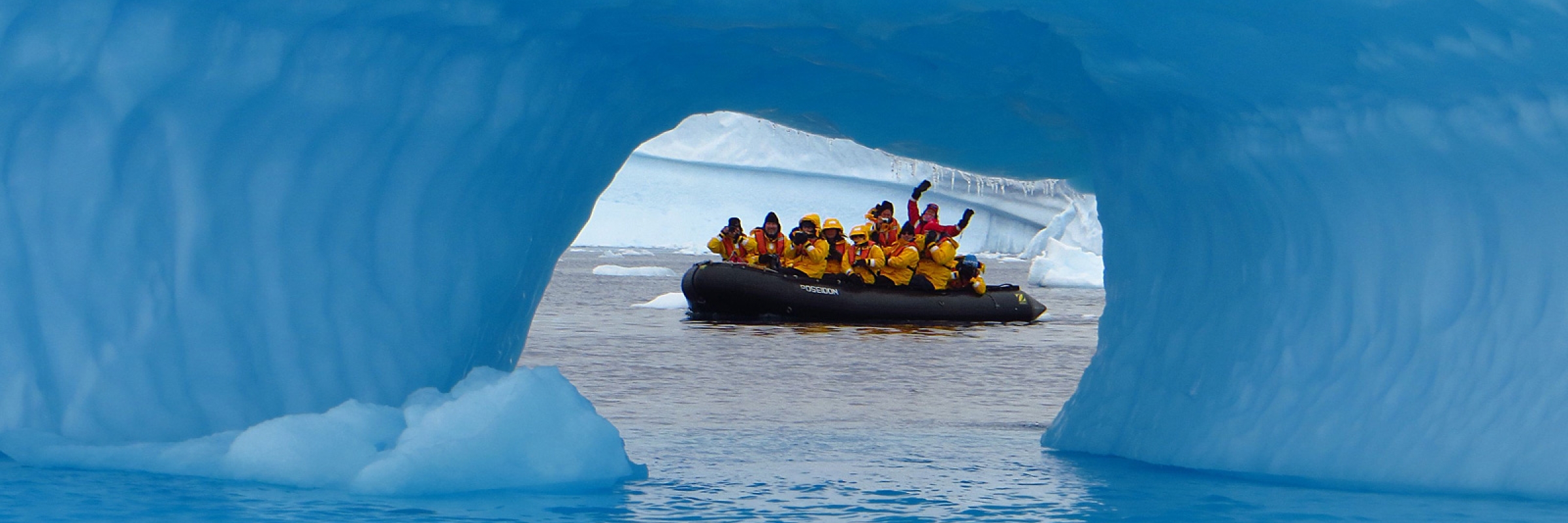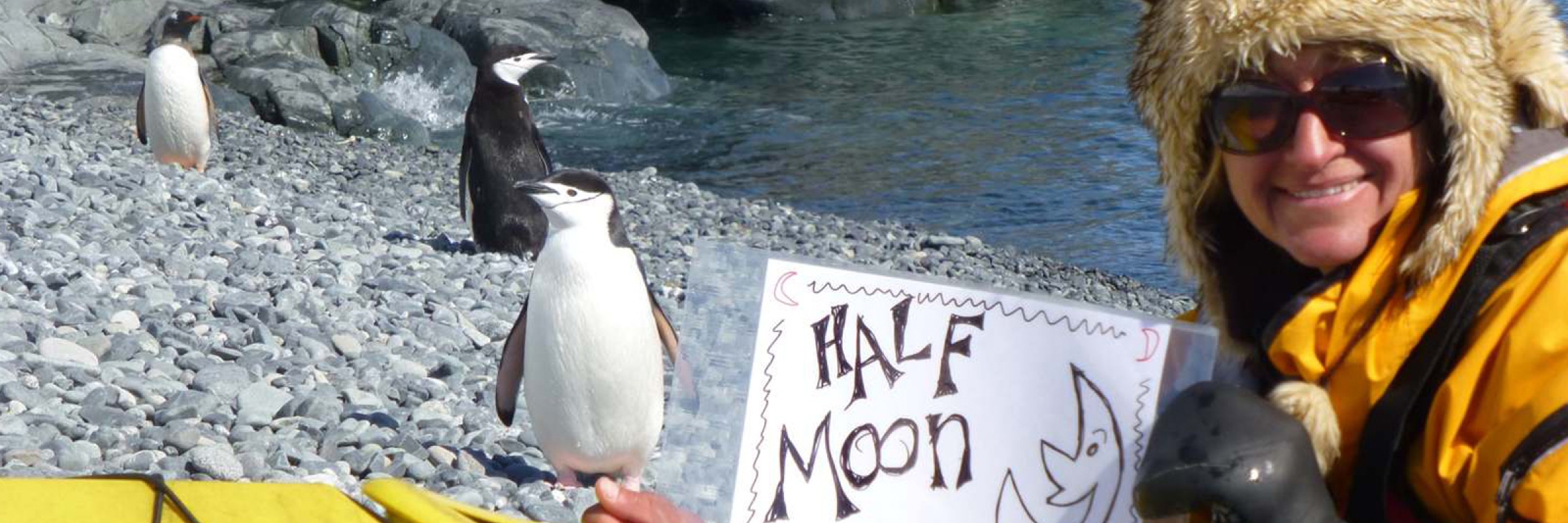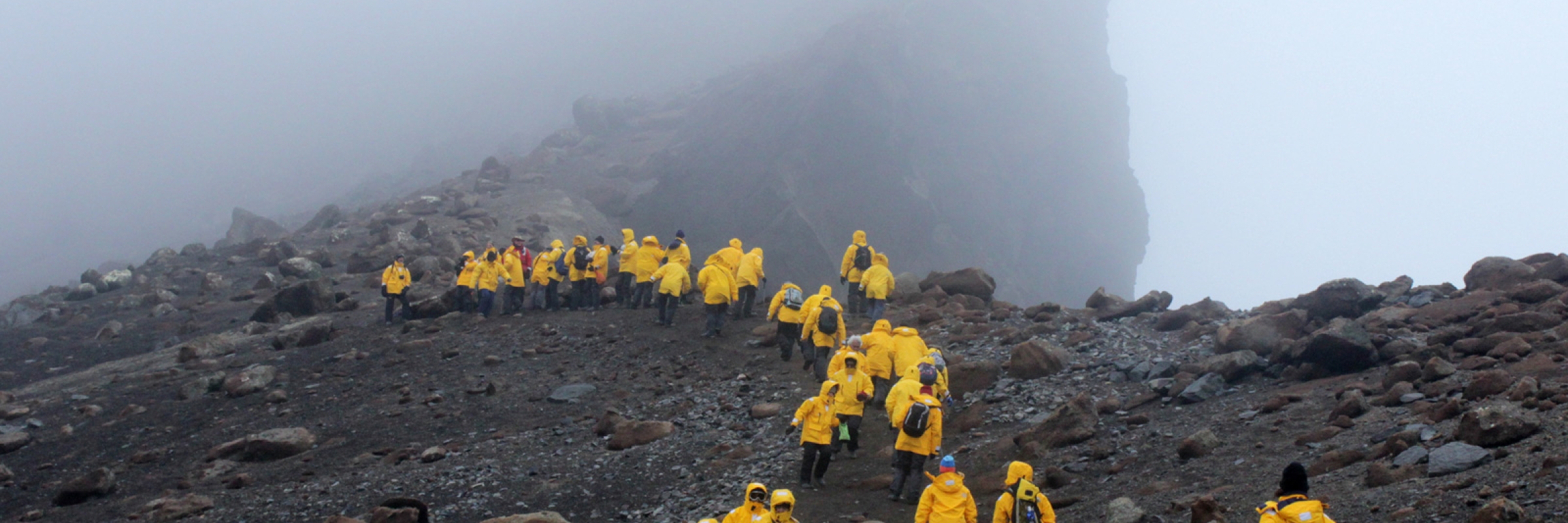Your gateway for this expedition is Ushuaia, Argentina. Nestled within the Tierra del Fuego archipelago, Ushuaia has a small-town feel yet boasts many shops, museums, cafés and restaurants that you can enjoy before your voyage. If you’re feeling adventurous, the nearby Tierra del Fuego National Park and Martial Glacier offer plenty of outdoor activities, such as hiking.
Epic Antarctica: Crossing the Circle via Falklands and South Georgia
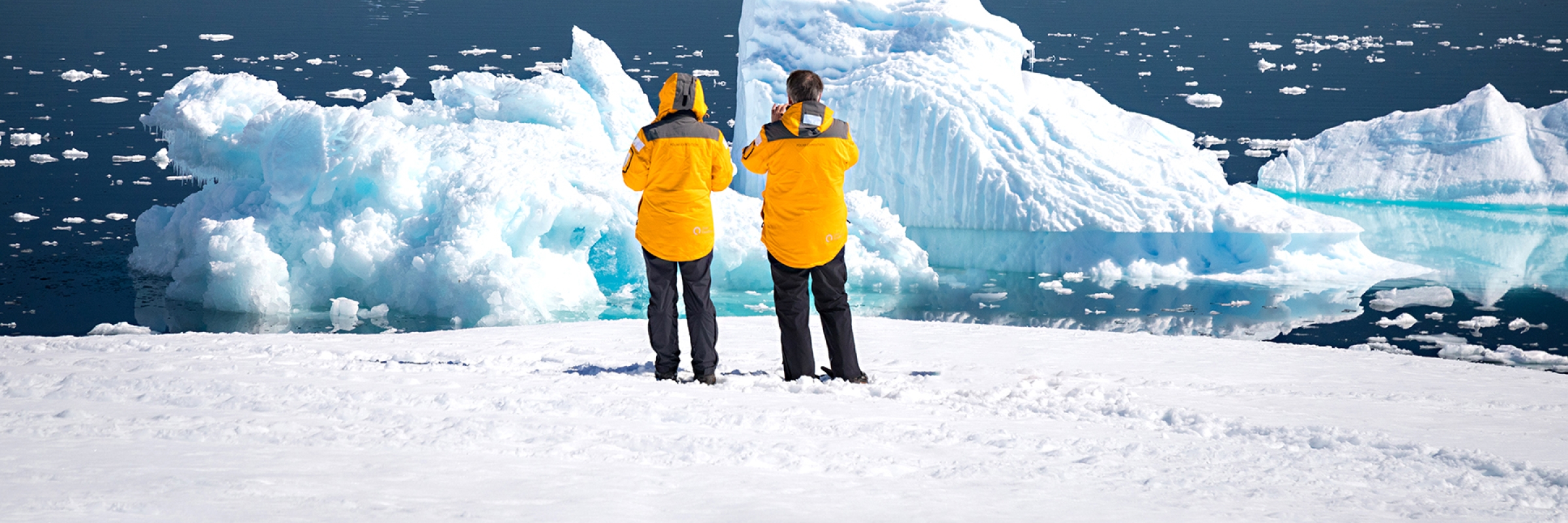
Our Epic Antarctica voyage is called so for a reason—it includes all of the major Antarctic highlights you can imagine. From the Falkland Islands (Islas Malvinas) to South Georgia to the Antarctic Peninsula, you will have countless unforgettable moments on this adventure-packed, 23-day voyage. Start with the Falklands, reminiscent of both sandy Cape Cod and the English moors, home to albatross, dolphins, and five species of penguins. From there, venture to South Georgia where you’ll enter the home of 300,000 breeding king penguins, 50 million other seabirds and 5 million seals. Then, explore the stunning Antarctic Peninsula, and finally cross the Antarctic Circle—a significant milestone for any world traveler.
Starting in 2021, this itinerary allows you to the opportunity to experience our pioneering new vessel, Ultramarine. This purpose-built vessel is designed to extend the boundaries of polar exploration and offer an unmatched Antarctic experience, including a flightseeing tour you’ll never forget and a range of adventure options more extensive than any other ship in its class.
- Explore the world’s seventh continent on the Antarctic Peninsula by ship, Zodiac and on foot;
- Learn about Antarctica’s unique geology, history and wildlife with an expert team of lecturers;
- See the incredible wildlife of South Georgia, often referred to as “the Galapagos of the South.” This includes more than 30 species of breeding birds, including four species of penguin;
- Follow in the footsteps of Sir Ernest Shackleton’s perilous voyage on South Georgia and pause for a moment at his graveside;
- Explore the quaint, British town of Port Stanley in the Falkland Islands;
- Crossing of the Antarctic Circle; and
- On board lecturers and educational presentations from Polar specialists.
行程
Day 1 — Arrive in Ushuaia, Argentina
Day 2 — Embark
As you embark, the anticipation grows. Trade your land legs for sea legs, meet and greet your fellow travelers and get acquainted with your ship. Since every Antarctic adventure presents new opportunities and experiences, embarkation day is just as exciting for your Expedition Team as it is for you. On board to ensure your comfort and safety, your team will also help make your wildlife dreams come true.
Day 3 — At Sea
Your days at sea are filled with presentations led by your Expedition Team who will prepare you for the wildlife, glaciology and history that will greet you upon your arrival. In between presentations, spend time on deck looking for wildlife or chatting with your shipmates over a drink at the bar.
Days 4 & 5 — Falkland Islands (Islas Malvinas)
Upon your arrival in the Falklands (Malvinas), your camera will get its first real workout capturing the abundant wildlife and rugged feel of this sub-Antarctic region. The archipelago contains two main islands, East Falkland and West Falkland, which you will explore during daily Zodiac excursions and landings.
Stanley, also known as Port Stanley, is often a favored landing site, as the town offers a unique British outpost feel, complete with eclectic charm. You’ll be free to explore, grab a pint at the local pub or visit the cathedral and museum.
The Archipelago is rich in wildlife, especially birds, and home to Magellanic, gentoo, and southern rockhopper penguins. If you’re lucky, you may even spot king penguins here as well! You can expect to see black-browed albatross, plus two endemic bird species—the flightless Falkland steamer duck and possibly the elusive Cobb’s wren.
Your expert education team will be sure to enrich your understanding of the local flora and fauna, making the most out of your time in the Falklands.
Days 6 & 7 — At Sea
Sailing southeast to South Georgia, you’ll officially enter Antarctic waters once you cross the Antarctic Convergence, an invisible biological boundary encircling the continent. This meeting of oceans, where the cold Antarctic waters mix and mingle with the warmer waters of the Indian, Pacific and Atlantic Oceans, helps nourish the abundance of krill that attracts whales, seals, and birdlife to this part of the world. Your Expedition Team will notify you when you cross this invisible yet important line, and also look out for the seabirds and marine life that frequent the area.
Days 8 to 11 — South Georgia
This remote, mountainous island was a popular stop for many historic Antarctic expeditions and was once a haven for hunting whales and seals. Today, island wildlife populations are rebounding, but you’ll still see remnants of old whaling stations and other abandoned outposts.
One significant and historic site is the grave of the great explorer Sir Ernest Shackleton. You can visit his grave at the settlement of Grytviken, which is also home to an old whaling station, plus a museum, gift shop, church and small research station.
Although South Georgia’s history is an important attraction to the island, it is the tremendous abundance of wildlife that you and your shipmates will surely find most captivating. Each landing you make on South Georgia, often referred to as the Galapagos of the Poles, will open your eyes to the wondrous lives of new, enthralling creatures.
One day you may see rookeries with hundreds of thousands of pairs of king penguins waddling on a beach, and the next, you may visit another beach blanketed with hundreds of fur or elephant seals. The grasses, mountains and beaches of South Georgia all play an important role in the breeding and survival of different species on the island. This fragile and interwoven relationship is something your Expedition Team will instill in you during your time here.
Days 12 & 13 — At Sea
Say goodbye to the king penguins, as your next destination is Antarctica! Your days at sea are filled with presentations, workshops, and social activities led by your Expedition Team.
Days 14 to 16 — South Shetland Islands and Antarctic Peninsula
The experience is hard to put into words, but the most common reaction upon reaching the White Continent is a sense of reverence and awe. You will discover that Antarctica is a land of extremes: at one moment you’ll be overcome with a feeling of complete silence and solitude; the next, you’ll be laughing at the comical antics of a curious penguin.
Zodiac cruising, visits to historical sites and, of course, communing with seals and penguins are sure to keep you smiling every day. Perhaps you’ll catch sight of the fearless penguin eater, the leopard seal, or maybe you’ll come eye to eye with a humpback whale while you are cruising in a Zodiac. Each day and each excursion will present a new collection of creatures to delight you and keep your camera busy.
If you find yourself wanting more, treat yourself to an optional kayaking adventure (reserve in advance when booking your trip) or a swim in Antarctic waters during the Polar Plunge!
Days 17 & 18 — Antarctic Circle
Crossing the Antarctic Circle is both a memorable experience and impressive achievement, as few travelers reach so far south. If conditions allow us to cross this famed latitude of 66°33´ S, we’ll toast the first explorers who ventured here, and you can raise a glass and take pride in knowing you’ve made it to a part of the world visited by very few people. This is raw Antarctica, home of the midnight sun, Weddell seals, and your best chances of encountering sea ice – the foundation of the Antarctic marine ecosystem.
Days 19 & 20 — Northbound Along the Peninsula
If you haven’t had your fill of Antarctic wildlife and icebergs by now, you’ll surely be satisfied by the time you return to the Drake Passage. You will continue to make excursions by Zodiac as you travel north along the western Antarctic Peninsula.
Your Expedition Team will always be on the lookout for species of seabirds, seals and whales that may have eluded you on your journey south.
Days 21 & 22 — Crossing the Drake Passage
After more than three weeks of unique wildlife encounters and remarkable landscapes, your journey home begins. Crossing the Drake is your unofficial rite of passage, putting a final stamp of approval on your Antarctic adventure.
Day 23 — Disembark in Ushuaia
After breakfast aboard the ship, it is time to part ways and say goodbye to your Expedition Team. Airport transfers will be provided for those departing on the first homeward flights. Other guests will be transferred to town.

Day 1 — Arrive in Buenos Aires, Argentina
You may arrive in Buenos Aires at any time during Day 1 of your itinerary. Upon arriving in this splendid city, known for its architecture and rich European heritage, you will independently transfer to your group hotel (pre-expedition hotel night included in mandatory transfer package).
Day 2 — Fly to Ushuaia and Embark
After an early breakfast at the hotel, the group will transfer to the airport and board our private charter flight to Ushuaia, Argentina.
Upon arrival, you will be transferred from the airport to a central downtown location to have some time on your own to explore this quaint port town before making your way to the pier.
After a late afternoon embarkation, you will sail along the historic Beagle Channel, which transects the Tierra del Fuego archipelago in the extreme south of South America. Expect an air of anticipation as you depart—the next time you see land, you’ll be in a wildlife wonderland!
Day 3 — At Sea
Your days at sea are filled with presentations led by your Expedition Team who will prepare you for the wildlife, glaciology and history that will greet you upon your arrival. In between presentations, spend time on deck looking for wildlife or chatting with your shipmates over a drink at the bar.
Days 4 and 5 — Falkland Islands (Islas Malvinas)
Upon your arrival in the Falklands (Malvinas), your camera will get its first real workout capturing the abundant wildlife and rugged feel of this sub-Antarctic region. The archipelago contains two main islands, East Falkland and West Falkland, which you will explore during daily Zodiac excursions and landings.
Stanley, also known as Port Stanley, is often a favored landing site, as the town offers a unique British outpost feel, complete with eclectic charm. You’ll be free to explore, grab a pint at the local pub, or visit the numerous churches and museums.
The Archipelago is rich in wildlife, especially birds, and home to Magellanic, gentoo and southern rockhopper penguins. If you’re lucky, you may even spot king penguins here as well! You can expect to see black-browed albatross, plus two endemic bird species—the flightless Falkland steamer duck, and possibly, the elusive Cobb’s wren.
Your expert education team will enrich your understanding of the local flora and fauna, helping you make the most of your time in the Falklands.
Days 6 and 7 — At Sea
Sailing southeast to South Georgia, you’ll officially enter Antarctic waters once you cross the Antarctic Convergence, an invisible biological boundary encircling the continent. This meeting of oceans, where the cold Antarctic waters mix with the warmer waters of the Indian, Pacific and Atlantic Oceans, helps nourish the abundance of krill that attracts whales, seals, and birdlife to this part of the world. Your Expedition Team will notify you when you cross this invisible yet important line, and will also help you look out for the seabirds and marine life that frequent the area.
Days 8 to 11 — South Georgia
This remote, mountainous island was a popular stop for many historic Antarctic expeditions and was once a haven for hunting whales and seals. Today, island wildlife populations are rebounding, but you’ll still see remnants of old whaling stations and other abandoned outposts.
Among the most significant and moving sites on South Georgia is the grave of the great explorer Sir Ernest Shackleton. You can visit his grave at the settlement of Grytviken, which is also home to an old whaling station, plus a museum, gift shop, church and small research station.
Although South Georgia’s history is an important attraction to the island, it is the tremendous abundance of wildlife that you and your shipmates will surely find most captivating. Each landing you make on South Georgia, often referred to as the Galapagos of the Poles, will open your eyes to the wondrous lives of new, enthralling creatures.
One day you may see rookeries with hundreds of thousands of pairs of king penguins waddling on a beach, and the next, you may visit another beach blanketed with hundreds of fur or elephant seals. The grasses, mountains and beaches of South Georgia all play an important role in the breeding and survival of different species on the island. Your Expedition Leaders will help you understand and appreciate the delicate balance among these fragile and interwoven relationships.
Days 12 and 13 — At Sea
Say goodbye to the king penguins, as your next destination is Antarctica! Your days at sea are filled with presentations, workshops, and social activities led by your Expedition Team.
Days 14 to 16 — South Shetland Islands and Antarctic Peninsula
The experience is hard to put into words, but the most common reaction upon reaching the White Continent is a sense of reverence and awe. You will discover that Antarctica is a land of extremes: at one moment you’ll be overcome with a feeling of complete silence and solitude; the next, you’ll be laughing at the comical antics of a curious penguin.
Zodiac cruising, visits to historical sites and, of course, communing with seals and penguins are sure to keep you smiling every day. Perhaps you’ll catch sight of the fearless penguin eater, the leopard seal, or maybe you’ll come eye to eye with an Antarctic minke whale while you cruise in a Zodiac. Each day, and each excursion, will present a new collection of creatures to delight you and keep your camera busy.
If you find yourself wanting more, treat yourself to an optional kayaking adventure (reserve in advance when booking your trip), or cast reason aside and join in the Polar Plunge—it’s something you’ll never forget!
Days 17 and 18 — Antarctic Circle
Crossing the Antarctic Circle is both a memorable experience and impressive achievement, as few travelers reach so far south. If conditions allow us to cross this famed latitude of 66°33´ S, we’ll toast the first explorers who ventured here, and you can raise a glass and take pride in knowing you’ve made it to a part of the world visited by very few people. This is raw Antarctica, home of the midnight sun, Weddell seals, and your best chances of encountering sea ice – the foundation of the Antarctic marine Ecosystem.
Days 19 and 20 — Northbound Along the Peninsula
If you haven’t had your fill of Antarctic wildlife and icebergs by now, you’ll surely be satisfied by the time you return to the Drake Passage. You will continue to make excursions by Zodiac as you travel north along the western Antarctic Peninsula.
Your Expedition Team will always be on the lookout for species of seabirds, seals and whales that may have eluded you on your journey south.
Days 21 and 22 — Crossing the Drake Passage
After more than three weeks of unique wildlife encounters and remarkable landscapes, your journey home begins. The unpredictable and exciting Drake Passage is an adventure unto itself. While being well taken care of by our expert onboard staff, you’ll have plenty of time to gaze out at the ocean, take pictures of seabirds swooping around the ship, and reflect on your remarkable Antarctic adventure.
Day 23 — Disembark in Ushuaia and Fly to Buenos Aires
You will arrive in Ushuaia in the morning and disembark after breakfast. The mandatory transfer package includes a little taste of Patagonia with a Tierra del Fuego National Park tour before transferring to the airport for the return group charter flight to Buenos Aires.

Day 1 — Arrive in Ushuaia, Argentina
Your gateway for this expedition is Ushuaia, Argentina. Nestled within the Tierra del Fuego archipelago, Ushuaia has a small-town feel yet boasts many shops, museums, cafés and restaurants that you can enjoy before your voyage. If you’re feeling adventurous, the nearby Tierra del Fuego National Park and Martial Glacier offer plenty of outdoor activities, such as hiking.
Day 2 — Embark
As you embark, the anticipation grows. Trade your land legs for sea legs, meet and greet your fellow travelers and get acquainted with your ship. Since every Antarctic adventure presents new opportunities and experiences, embarkation day is just as exciting for your Expedition Team as it is for you. On board to ensure your comfort and safety, your team will also help make your wildlife dreams come true.
Day 3 — At Sea
Your days at sea are filled with presentations led by your Expedition Team who will prepare you for the wildlife, glaciology and history that will greet you upon your arrival. In between presentations, spend time on deck looking for wildlife or chatting with your shipmates over a drink at the bar.
Days 4 & 5 — Falkland Islands (Islas Malvinas)
Upon your arrival in the Falklands (Malvinas), your camera will get its first real workout capturing the abundant wildlife and rugged feel of this sub-Antarctic region. The archipelago contains two main islands, East Falkland and West Falkland, which you will explore during daily Zodiac excursions and landings.
Stanley, also known as Port Stanley, is often a favored landing site, as the town offers a unique British outpost feel, complete with eclectic charm. You’ll be free to explore, grab a pint at the local pub or visit the cathedral and museum.
The Archipelago is rich in wildlife, especially birds, and home to Magellanic, gentoo, and southern rockhopper penguins. If you’re lucky, you may even spot king penguins here as well! You can expect to see black-browed albatross, plus two endemic bird species—the flightless Falkland steamer duck and possibly the elusive Cobb’s wren.
Your expert education team will be sure to enrich your understanding of the local flora and fauna, making the most out of your time in the Falklands.
Days 6 & 7 — At Sea
Sailing southeast to South Georgia, you’ll officially enter Antarctic waters once you cross the Antarctic Convergence, an invisible biological boundary encircling the continent. This meeting of oceans, where the cold Antarctic waters mix and mingle with the warmer waters of the Indian, Pacific and Atlantic Oceans, helps nourish the abundance of krill that attracts whales, seals, and birdlife to this part of the world. Your Expedition Team will notify you when you cross this invisible yet important line, and also look out for the seabirds and marine life that frequent the area.
Days 8 to 11 — South Georgia
This remote, mountainous island was a popular stop for many historic Antarctic expeditions and was once a haven for hunting whales and seals. Today, island wildlife populations are rebounding, but you’ll still see remnants of old whaling stations and other abandoned outposts.
One significant and historic site is the grave of the great explorer Sir Ernest Shackleton. You can visit his grave at the settlement of Grytviken, which is also home to an old whaling station, plus a museum, gift shop, church and small research station.
Although South Georgia’s history is an important attraction to the island, it is the tremendous abundance of wildlife that you and your shipmates will surely find most captivating. Each landing you make on South Georgia, often referred to as the Galapagos of the Poles, will open your eyes to the wondrous lives of new, enthralling creatures.
One day you may see rookeries with hundreds of thousands of pairs of king penguins waddling on a beach, and the next, you may visit another beach blanketed with hundreds of fur or elephant seals. The grasses, mountains and beaches of South Georgia all play an important role in the breeding and survival of different species on the island. This fragile and interwoven relationship is something your Expedition Team will instill in you during your time here.
Days 12 & 13 — At Sea
Say goodbye to the king penguins, as your next destination is Antarctica! Your days at sea are filled with presentations, workshops, and social activities led by your Expedition Team.
Days 14 to 16 — South Shetland Islands and Antarctic Peninsula
The experience is hard to put into words, but the most common reaction upon reaching the White Continent is a sense of reverence and awe. You will discover that Antarctica is a land of extremes: at one moment you’ll be overcome with a feeling of complete silence and solitude; the next, you’ll be laughing at the comical antics of a curious penguin.
Zodiac cruising, visits to historical sites and, of course, communing with seals and penguins are sure to keep you smiling every day. Perhaps you’ll catch sight of the fearless penguin eater, the leopard seal, or maybe you’ll come eye to eye with a humpback whale while you are cruising in a Zodiac. Each day and each excursion will present a new collection of creatures to delight you and keep your camera busy.
If you find yourself wanting more, treat yourself to an optional kayaking adventure (reserve in advance when booking your trip) or a swim in Antarctic waters during the Polar Plunge!
Days 17 & 18 — Antarctic Circle
Crossing the Antarctic Circle is both a memorable experience and impressive achievement, as few travelers reach so far south. If conditions allow us to cross this famed latitude of 66°33´ S, we’ll toast the first explorers who ventured here, and you can raise a glass and take pride in knowing you’ve made it to a part of the world visited by very few people. This is raw Antarctica, home of the midnight sun, Weddell seals, and your best chances of encountering sea ice – the foundation of the Antarctic marine ecosystem.
Days 19 & 20 — Northbound Along the Peninsula
If you haven’t had your fill of Antarctic wildlife and icebergs by now, you’ll surely be satisfied by the time you return to the Drake Passage. You will continue to make excursions by Zodiac as you travel north along the western Antarctic Peninsula.
Your Expedition Team will always be on the lookout for species of seabirds, seals and whales that may have eluded you on your journey south.
Days 21 & 22 — Crossing the Drake Passage
After more than three weeks of unique wildlife encounters and remarkable landscapes, your journey home begins. Crossing the Drake is your unofficial rite of passage, putting a final stamp of approval on your Antarctic adventure.
Day 23 — Disembark in Ushuaia
After breakfast aboard the ship, it is time to part ways and say goodbye to your Expedition Team. Airport transfers will be provided for those departing on the first homeward flights. Other guests will be transferred to town.

Day 1 — Arrive in Buenos Aires, Argentina
You may arrive in Buenos Aires at any time during Day 1 of your itinerary. Upon arriving in this splendid city, known for its architecture and rich European heritage, you will independently transfer to your group hotel (pre-expedition hotel night included in mandatory transfer package).
Day 2 — Fly to Ushuaia and Embark
After an early breakfast at the hotel, the group will transfer to the airport and board our private charter flight to Ushuaia, Argentina.
Upon arrival, you will be transferred from the airport to a central downtown location to have some time on your own to explore this quaint port town before making your way to the pier.
After a late afternoon embarkation, you will sail along the historic Beagle Channel, which transects the Tierra del Fuego archipelago in the extreme south of South America. Expect an air of anticipation as you depart—the next time you see land, you’ll be in a wildlife wonderland!
Day 3 — At Sea
Your days at sea are filled with presentations led by your Expedition Team who will prepare you for the wildlife, glaciology and history that will greet you upon your arrival. In between presentations, spend time on deck looking for wildlife or chatting with your shipmates over a drink at the bar.
Days 4 and 5 — Falkland Islands (Islas Malvinas)
Upon your arrival in the Falklands (Malvinas), your camera will get its first real workout capturing the abundant wildlife and rugged feel of this sub-Antarctic region. The archipelago contains two main islands, East Falkland and West Falkland, which you will explore during daily Zodiac excursions and landings.
Stanley, also known as Port Stanley, is often a favored landing site, as the town offers a unique British outpost feel, complete with eclectic charm. You’ll be free to explore, grab a pint at the local pub, or visit the numerous churches and museums.
The Archipelago is rich in wildlife, especially birds, and home to Magellanic, gentoo and southern rockhopper penguins. If you’re lucky, you may even spot king penguins here as well! You can expect to see black-browed albatross, plus two endemic bird species—the flightless Falkland steamer duck, and possibly, the elusive Cobb’s wren.
Your expert education team will enrich your understanding of the local flora and fauna, helping you make the most of your time in the Falklands.
Days 6 and 7 — At Sea
Sailing southeast to South Georgia, you’ll officially enter Antarctic waters once you cross the Antarctic Convergence, an invisible biological boundary encircling the continent. This meeting of oceans, where the cold Antarctic waters mix with the warmer waters of the Indian, Pacific and Atlantic Oceans, helps nourish the abundance of krill that attracts whales, seals, and birdlife to this part of the world. Your Expedition Team will notify you when you cross this invisible yet important line, and will also help you look out for the seabirds and marine life that frequent the area.
Days 8 to 11 — South Georgia
This remote, mountainous island was a popular stop for many historic Antarctic expeditions and was once a haven for hunting whales and seals. Today, island wildlife populations are rebounding, but you’ll still see remnants of old whaling stations and other abandoned outposts.
Among the most significant and moving sites on South Georgia is the grave of the great explorer Sir Ernest Shackleton. You can visit his grave at the settlement of Grytviken, which is also home to an old whaling station, plus a museum, gift shop, church and small research station.
Although South Georgia’s history is an important attraction to the island, it is the tremendous abundance of wildlife that you and your shipmates will surely find most captivating. Each landing you make on South Georgia, often referred to as the Galapagos of the Poles, will open your eyes to the wondrous lives of new, enthralling creatures.
One day you may see rookeries with hundreds of thousands of pairs of king penguins waddling on a beach, and the next, you may visit another beach blanketed with hundreds of fur or elephant seals. The grasses, mountains and beaches of South Georgia all play an important role in the breeding and survival of different species on the island. Your Expedition Leaders will help you understand and appreciate the delicate balance among these fragile and interwoven relationships.
Days 12 and 13 — At Sea
Say goodbye to the king penguins, as your next destination is Antarctica! Your days at sea are filled with presentations, workshops, and social activities led by your Expedition Team.
Days 14 to 16 — South Shetland Islands and Antarctic Peninsula
The experience is hard to put into words, but the most common reaction upon reaching the White Continent is a sense of reverence and awe. You will discover that Antarctica is a land of extremes: at one moment you’ll be overcome with a feeling of complete silence and solitude; the next, you’ll be laughing at the comical antics of a curious penguin.
Zodiac cruising, visits to historical sites and, of course, communing with seals and penguins are sure to keep you smiling every day. Perhaps you’ll catch sight of the fearless penguin eater, the leopard seal, or maybe you’ll come eye to eye with an Antarctic minke whale while you cruise in a Zodiac. Each day, and each excursion, will present a new collection of creatures to delight you and keep your camera busy.
If you find yourself wanting more, treat yourself to an optional kayaking adventure (reserve in advance when booking your trip), or cast reason aside and join in the Polar Plunge—it’s something you’ll never forget!
Days 17 and 18 — Antarctic Circle
Crossing the Antarctic Circle is both a memorable experience and impressive achievement, as few travelers reach so far south. If conditions allow us to cross this famed latitude of 66°33´ S, we’ll toast the first explorers who ventured here, and you can raise a glass and take pride in knowing you’ve made it to a part of the world visited by very few people. This is raw Antarctica, home of the midnight sun, Weddell seals, and your best chances of encountering sea ice – the foundation of the Antarctic marine Ecosystem.
Days 19 and 20 — Northbound Along the Peninsula
If you haven’t had your fill of Antarctic wildlife and icebergs by now, you’ll surely be satisfied by the time you return to the Drake Passage. You will continue to make excursions by Zodiac as you travel north along the western Antarctic Peninsula.
Your Expedition Team will always be on the lookout for species of seabirds, seals and whales that may have eluded you on your journey south.
Days 21 and 22 — Crossing the Drake Passage
After more than three weeks of unique wildlife encounters and remarkable landscapes, your journey home begins. The unpredictable and exciting Drake Passage is an adventure unto itself. While being well taken care of by our expert onboard staff, you’ll have plenty of time to gaze out at the ocean, take pictures of seabirds swooping around the ship, and reflect on your remarkable Antarctic adventure.
Day 23 — Disembark in Ushuaia and Fly to Buenos Aires
You will arrive in Ushuaia in the morning and disembark after breakfast. The mandatory transfer package includes a little taste of Patagonia with a Tierra del Fuego National Park tour before transferring to the airport for the return group charter flight to Buenos Aires.

